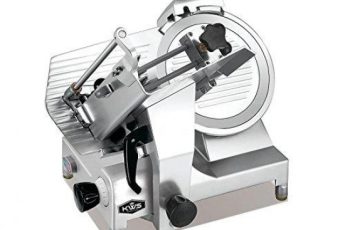The Genesis of the Spiral Ham Slicer
Hoenselaar and His Invention
In the late 19th century, specifically in 1898, a culinary genius named Hoenselaar brought the first spiral ham slicer. This wasn’t just a kitchen gadget but a revolution in how we consume ham. The device was simple yet effective, designed to make slicing ham easier and more aesthetically pleasing.
The prototype was a hit but not an overnight sensation. It took time for people to realize the convenience it offered. Imagine the holiday season without the hassle of carving ham; this invention made that dream a reality. The device was initially manual but evolved to incorporate more advanced features.
The Honey Baked Ham Co.
Fast forward to Detroit’s bustling restaurant scene, where Hoenselaar was busy jotting down ideas on napkins. He even took out a second mortgage on his house to fund the development of his invention. This passion led to the foundation of the Honey Baked Ham Co., which celebrated its 40th anniversary recently. The company became synonymous with quality spiral-sliced hams, making it a household name.
The Honey Baked Ham Co. didn’t just sell hams; it sold an experience. The hams were smoked over hardwood chips and hand-glazed with a sweet concoction that became a national sensation. The company’s success story is a testament to the impact of the spiral ham slicer on the culinary world.
Technological Advancements
As technology advanced, so did the spiral ham slicer. What started as a manual device soon incorporated electric motors and automated features. The modern versions are more user-friendly, efficient, and versatile, capable of slicing various hams precisely.
The device has also become more compact and kitchen-friendly, making it a staple in professional and home kitchens. It’s not just about slicing ham anymore; it’s about doing it as efficiently and elegantly as possible.
Types of Spiral Ham Slicers
Precooked and Precut Hams
When it comes to spiral ham slicers, you have options. One popular choice is the precooked and precut city hams. These are convenient and ready to eat, making them a go-to option for busy households. However, it’s essential to read the ingredients list carefully. Some hams come with preservatives or added sugars that you might want to avoid.
| Type of Ham | Convenience Level | Preservatives |
|---|---|---|
| City Ham | High | Varies |
| Country Ham | Low | Minimal |
Boneless Spiral Hams
Another option is the boneless spiral ham. These are incredibly convenient and cost-effective. However, purists might argue that a bone-in ham offers a richer flavor. Boneless hams are easier to slice and serve, making them a practical choice for large gatherings.
| Type of Ham | Flavor Intensity | Ease of Slicing |
|---|---|---|
| Boneless Ham | Moderate | High |
| Bone-in Ham | Rich | Moderate |
Artistic Variants
Artistic variants of spiral ham slicers are available for those who like a bit of flair in their culinary adventures. These come with customized blades and designs that add a unique touch to your ham slices. While these might not be for everyone, they make for a great conversation starter at dinner parties.
Mechanism and Functionality

Blade Design
The blade of a spiral ham slicer is more than just a sharp piece of metal. It’s engineered to perfection, usually disposed at a 45-degree angle to the vertical axis. This specific angle allows for a single, continuous spiral slice of ham, which is visually appealing and easy to serve.
The blade is mounted on a carriage that rotates on a substantially vertical axis. This rotation and the blade’s axial movement ensure that each slice is as perfect as the last. It’s like having a professional chef in your kitchen dedicated solely to slicing ham.
Thickness Variability
One of the most intriguing features of a spiral ham slicer is its ability to adjust the thickness of the slices. This is crucial because not everyone likes their ham sliced the same way. Some prefer thicker slices for grilling, while others like them thin for sandwiches.
The device usually has a knob or a digital panel to adjust the thickness. This feature eliminates the common issues of missed cuts or uneven slices, ensuring each slice is a prime product ready to savor.
Additional Features
Modern spiral ham slicers have many additional features that make them even more versatile. For instance, some models offer hands-free operation, allowing you to multitask in the kitchen. Others come with safety features like blade guards and automatic shut-off to prevent accidents.
These additional features are not just bells and whistles; they add genuine value to the device. They make slicing ham efficient and enjoyable, turning it into a culinary experience rather than a mundane task.
Cooking Techniques: Mastering the Art of Spiral-Sliced Ham
Traditional Oven Baking
Oven baking is the tried-and-true method for cooking a spiral-sliced ham to perfection. Preheat the oven to 350°F and place the ham in a roasting pan. Cover it with foil to lock in moisture and bake for 10 minutes per pound.
This method allows for even cooking and allows you to add your glazes and seasonings. Popular glaze options include a mixture of honey, brown sugar, and a touch of mustard or cloves. The final product is a succulent, juicy ham with a crispy, flavorful crust.
| Oven Temperature | Cooking Time per Pound | Glaze Options |
|---|---|---|
| 350°F | 10 minutes | Honey, Brown Sugar |
Pressure Cooking: The Quick and Easy Route
If you’re pressed for time, pressure cooking is a fantastic alternative. This method is beneficial for those last-minute dinner plans or unexpected guests. Wrap the spiral-sliced ham in heavy-duty aluminum foil and place it on a rack at the bottom of the pressure cooker.
Heat for about 12 minutes, and your ham is ready to serve. The pressure cooker locks in the juices, making the ham tender and flavorful. Plus, it’s a great way to free up oven space for other dishes.
| Cooking Method | Time Required | Juiciness Level |
|---|---|---|
| Pressure Cooking | 12 minutes | High |
Serving Suggestions: The Final Touch
Once the ham is cooked, the presenter becomes the show’s star. Spiral-sliced ham offers the advantage of easy serving, but why stop there? Elevate your dish with garnishes like sliced carrots, cherry tomatoes, baby corn, and pineapple slices.
Drizzle some maple syrup or honey for that extra touch of sweetness. You can even sprinkle of fresh herbs like rosemary or thyme to enhance the flavors. The goal is to create a feast for the eyes and the palate.
Economic Aspects: The Investment Worth Making
Cost of the Slicer: A Long-Term Gain
While the initial investment in a spiral ham slicer can range from $200 to $500, the long-term benefits are manifold. Not only do you save on the cost of pre-sliced hams, but you also gain the freedom to slice other meats, fruits, and vegetables. This multi-functionality turns the slicer into a versatile kitchen tool, offering value for money.
Market Availability: Choices Galore
The market is flooded with options when it comes to spiral ham slicers. Brands like Chef’sChoice, Hobart, and Berkel offer a range of models to suit different needs and budgets. Online platforms provide customer reviews, video demonstrations, and even comparison charts to help you make an informed decision. A buyer’s market is out there, and you’re spoilt for choice.
Maintenance and Durability: Built to Last
A high-quality spiral ham slicer is a durable piece of equipment. Made with robust metal construction and high-quality blades, these slicers are built to last. Maintenance is generally straightforward—just a bit of regular cleaning and occasional blade sharpening. Some models even come with a warranty, offering peace of mind and making it a worthwhile investment.
Case Studies: Real-World Impact of Spiral Ham Slicers
HoneyBaked Ham Inc.: A Culinary Empire
HoneyBaked Ham Inc. is more than just a company; it’s a culinary empire built on the foundation of quality spiral-sliced hams. With its headquarters in Toledo, Ohio, the company has expanded its reach to 37 states.
Their product range has diversified to include other meats, but their spiral-sliced hams remain the show’s star. Their success is a testament to the power of a simple kitchen tool to revolutionize an industry.
Smithfield: The Competitive Edge
Smithfield is another major player that has carved a niche in the spiral-sliced ham market. They’ve focused on offering a range of flavors and glazes, from smoky bourbon to sweet cinnamon. This variety and competitive pricing have made them a popular choice among consumers. Smithfield’s strategy shows how innovation and variety can give a company a competitive edge.
Home Users: The Unsung Culinary Heroes
While companies like HoneyBaked Ham Inc. and Smithfield have commercialized the spiral ham slicer, the real heroes are the home cooks who have embraced this tool.
From holiday feasts to weekend barbecues, these home users have shown that you don’t need to be a professional chef to create a culinary masterpiece. Their experiences and testimonials are real-world case studies of the spiral ham slicer’s impact on everyday cooking.
Conclusion
The spiral ham slicer has come a long way since its invention in 1898. It’s not just a kitchen gadget; it’s a culinary revolution that has changed how we consume ham. Its advanced features, versatility, and economic benefits make it a worthy investment for anyone who takes their ham seriously.








